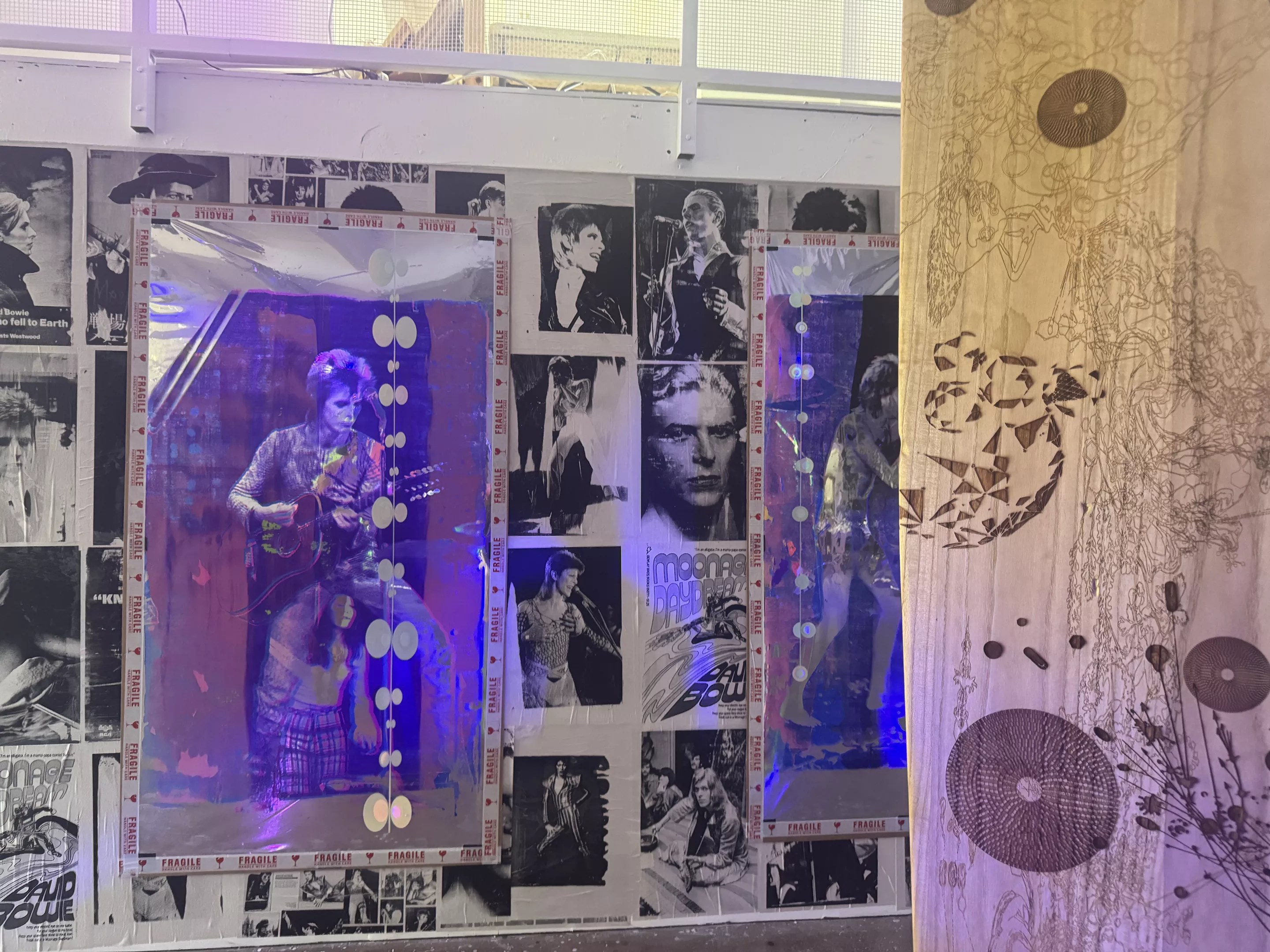
Locust Projects photo

Audio By Carbonatix
In the late 1970s, David Bowie released one of the most renowned trilogies in the history of mass media with his albums Low, “Heroes,” and Lodger – all released over a particularly prolific 16-month period in the paradigm-shifting musician’s life. He’d already secured his spot among the most influential musicians of his era with all-timers like The Rise and Fall of Ziggy Stardust and the Spiders from Mars, Aladdin Sane, and Young Americans. He’d continue his streak as a forward-thinking force right up until his last album, Blackstar, released just two days before his death in January 2016. Drawing upon this rich legacy, artist Tomas Vu is completing his own trilogy of works inspired by the late musician.
Blackstar 16/25/60, on display at Locust Projects, is an ambitious, immersive installation that fuses analog nostalgia with futuristic speculation. Vu’s installation channels the late artist’s fluid, genre-bending cultural legacy, creating a multimedia experience that doubles as both sanctuary and warning.
Vu, a Vietnamese artist and longtime Columbia University professor, is no stranger to layering personal history with global narrative. His trilogy began in Berlin in 2019 with Space Oddity 69/19/45, a show that touched on the optimism surrounding technological progress and space exploration. It was rooted in Vu’s own memory of watching the moon landing in a bar full of GIs and civilians in wartime Vietnam. As a child, he experienced not just the ghostly broadcast on a grainy black-and-white TV, but the collective emotional weight of the moment. He remembers grown men crying, overcome by the promise of a dazzling, space-age future.
His second installment, The Man Who Fell to Earth 76/22, presented in New York, addressed the unraveling of that promise. Vu used Bowie’s alien alter ego from the 1976 film as a metaphor for how technological advancement, coupled with human fallibility, can spiral into dystopia. That installation meditated on the failures of progress – pollution, addiction, disconnection – while keeping one eye on the not-so-distant future.
This year, make your gift count –
Invest in local news that matters.
Our work is funded by readers like you who make voluntary gifts because they value our work and want to see it continue. Make a contribution today to help us reach our $30,000 goal!
With Blackstar 16/25/60, Vu completes the arc. The optimism of the first chapter has dimmed, and the artist imagines a world where nature has reclaimed dominance, raising timely questions about humanity’s survival, legacy, and memory.

Vu uses Bowie’s shape-shifting presence as a metaphor for the current moment.
Tomas Vu photo
At the center of the installation is a mirrored, hexagonal geodesic dome inspired by the visionary architect Buckminster Fuller, a recurring figure in Vu’s work. Constructed by hand using plexiglass and reflective materials, the dome references both utopian architecture and disco-ball aesthetics. Visitors can lie down underneath the dome, play records inside it, or simply gaze upon the algorithmically generated collage of images and videos – many drawn from Vu’s archive and previous works – that are projected onto its panels. The result is an ever-shifting sensory environment where past and future fold in on themselves.
“The dome is like a time capsule and a time machine,” Vu tells New Times. “It’s analog and digital. It’s nostalgic, but also looking forward. It’s where we can dream again, but also where we’re asked to reflect.” That analog-digital tension is a key element of the exhibition. One of its major components is an old-school record player that invites visitors to cue up LPs from Bowie’s full discography, spanning 1967 to 2016. The soundscapes are customizable, interactive, and evoke the musician’s ethos of transformation, collaboration, and cultural remix. “We all have our own Bowie story,” Vu says. “That’s why this has to be collective. Everyone who enters brings something different.”
Community activation is at the epicenter of Blackstar 16/25/60. The dome will serve as a site for live music, performances, workshops, and even overnight stays. Vu encourages local artists, musicians, and collectives to “occupy” the space and leave their imprint. Each activation will be documented with the goal of eventually compiling a book that traces the trilogy’s evolution across time and cities. “The audience completes the work,” Vu stresses.

Tomas Vu: The Man Who Fell to Earth, installation view at the Boiler, NYC 2022
Locust Projects photo
This approach democratizes the installation and reinforces one of its central themes: resistance to the passive consumption of culture and information. Vu warns of the dangers of ceding too much ground to technology, invoking futurists like Ray Kurzweil and darker figures like Ted Kaczynski to underscore the conflicting results of so-called “progress.” Vu is thinking about the specter of AI, for example. He’s fed biographical data into a chatbot and been shocked by its uncanny, self-aware responses. “It knew me too well,” he says. “It talked about me in ways I hadn’t articulated myself.”
While the exhibition engages with significant, thorny concepts such as climate collapse, the end of human agency, and the possibility of rebirth, it never slips into despair. Psychedelic colors, glittering surfaces, and sensory delights punctuate the space, balancing urgency and awe. “I didn’t want it to be too dark,” says Vu. “There’s still joy. There’s still hope. The end can also be a beginning.”
Ultimately, Blackstar 16/25/60 is more than a tribute to Bowie. It’s a meditation on the contemporary condition through the prism of one artist’s life and cultural impact. Vu uses Bowie’s shape-shifting presence as a metaphor for the current moment, when identities are fluid, boundaries are blurred, and the future feels equally dazzling and dangerous. By inviting visitors to participate, reflect, and even play, the installation suggests the most vital response to uncertainty may be collective imagination.
Tomas Vu’s Blackstar 16/25/60. On view 11 a.m. to 5 p.m. Wednesdays through Saturdays from April 30 to July 19 at Locust Projects, 297 NE 67th St., Miami; 305-576-8570; locustprojects.org. Admission is free.